|
 |
|
The Thorneycroft family (originally
Thornicroft) originated in Cheshire in the 13th century. In
the 1660s John and Katherine Thornicroft moved to Broseley,
Shropshire, where their son John was born in 1663.
John’s grandson, Edward Thorneycroft
married Mary Bradley, and they had a daughter, Maria, born
in 1787. Around 1790 they moved to Tipton, Staffordshire,
where Edward became landlord of ‘The Three Furnaces’ public
house. Their next two children, twin boys, Edward Charles,
and George Benjamin, were born there on 20th August, 1791.
They went to a local school, but George had little interest
in class work, and only learned to read because his mother
made him read the bible. His main interests were anything to
do with mechanics, or chemistry. At night he would go into a
nearby iron works and became fascinated with everything that
he saw, learning many processes that would be useful to him
in future years.
The family moved to Kirkstall, Leeds
where Edward senior worked at Kirkstall Forge. He was soon
joined by his twin sons who began their working life at the
forge, and attended evening classes to learn about iron
manufacture. George began to put to good use many of the
things that he had learned from his night-time visits to the
Tipton iron works.
In 1809 at the age of 18, the two
brothers returned to Staffordshire. George became an iron
puddler at Addenbrooke’s Moorcroft Ironworks at Bradley, and
soon discovered a method of producing better quality iron at
a cheaper price. Mr. Addenbrooke was delighted. He promoted
George to superintendent of the works, and gave him a share
of the profits. It was in this role that he established his
abilities as a confident leader.
After about two years he saved £600, a
lot of money at the time, and married Eleanor Page, daughter
of Thomas and Hannah Page, of Moxley. In 1817 he invested
his savings, along with Eleanor’s £300 dowry, in a small
ironworks that he opened at Forge Yard, Waterglade Street,
Willenhall.
George, Eleanor, and their first
daughter, Ann, who was 12 months old, moved to
Willenhall and lived in a cottage that stood on the site of
the HSBC bank, on the corner of New Road and Market Place.
It was here that their next four children were born; Mary in
1818, John in 1820, Emma in 1821, and Thomas (later known as
Colonel Tom Thorneycroft of Tettenhall Towers) in 1822. The
ironworks was unsuccessful and so George began dealing in
pig iron, and became wealthy on the proceeds. In his early
years George was a staunch Wesleyan Methodist, who later
joined the Church of England, and gave generously to
Willenhall Chapel. |
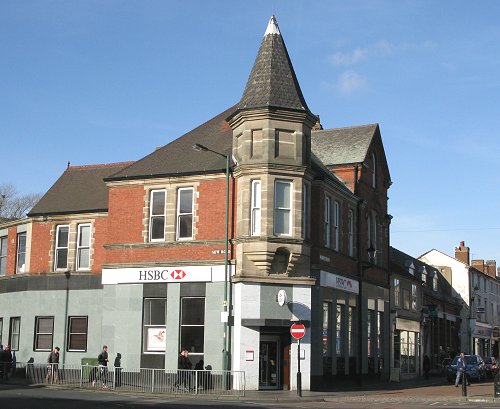
The HSBC Bank in Willenhall which
stands on the site of the Thorneycroft family's cottage. |
In 1824 he invested £1,800 in a new
venture with his brother Edward, and established the
Shrubbery Iron Works, in Lower Walsall Street,
Wolverhampton.
The works were in two halves with Lower
Walsall Street in the middle, and the Birmingham Canal
running alongside.
All of the chimneys were confined to
the northern half of the works between Lower Walsall Street
and Horseley Fields, so the iron must have been produced and
worked there. |
| In the beginning the works were quite small, producing
about 10 tons of iron each week, but thanks to George’s
expertise the business soon grew.
In a short while the output increased to between 600 and
700 tons a week, and the iron works became well known as
producers of high quality iron.
The two brothers worked together for several years, but
eventually they dissolved the partnership by mutual consent,
and Edward departed.
George continued to run Shrubbery Ironworks under his
company, G.B. Thorneycroft & Company. In later years his
partners were John Hartley, Thomas
Thorneycroft, John Perks, and Thomas Thorneycroft Kesteven.
The company also owned Bradley Colliery, the small
Millfields Ironworks at Bilston, and Dyer’s Hall Wharf in
London. |
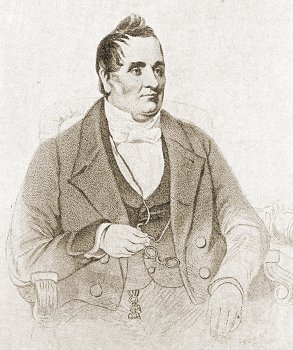
George Benjamin Thorneycroft. |
|
In the late 1830s and early 1840s
railway mania swept through the country. As a result the
demand rapidly grew for rails and railway ironwork. George
Thorneycroft wrote to the newly formed railway companies
suggesting that all rails should be tested, and that many
manufacturers were supplying inferior materials. As a result
the ironworks received many orders from the railways and
became known as a supplier of high quality axles. |
|
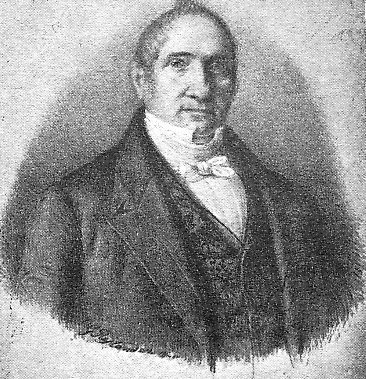
George, later in life. |
George owned a number of coal mines,
and nearly lost his life in one of them. In December 1845 a
new pumping engine was being installed at one of his pits in
Willenhall. Unfortunately the safety valve was faulty, and
the boiler exploded, killing one man, and seriously injuring
sixteen others. George was amongst the sixteen casualties.
On regaining consciousness his first words were “Praise the
Lord O my soul.” Followed by “Who else was hurt?”
One year later, with his doctor, Mr. E.
Coleman, he presented himself before lecturing staff and
students at Queen’s College, Birmingham to demonstrate how
the severe burns covering much of his body, had been healed
by the use of cotton wool freely applied to the dressings.
George, a keen Conservative, was one of
the two guests of honour at the first Conservative
Association dinner which was held at the Star & Garter in
Wolverhampton. The other principal guest was Lord Ingestre. |
|
George became Wolverhampton’s first
mayor after the town’s incorporation in 1848. There were two
candidates, George, and John Barker, the ironmaster at
Chillington Ironworks. They were from rival political
parties, but good friends. After an amicable discussion John
Barker withdrew, and George became mayor.
He decided to give a mace to the new
corporation, and purchased the silver mace from St. Mawes in
Cornwall, which he found at Fown and Emmanuel’s
establishment in London. The mace had been in use until 1832
when the borough of St. Mawes was abolished by the Great
Reform Act. The mace is still the Wolverhampton mace today.
In 1850 George laid the foundation
stone of the exchange building that stood in Exchange Street
opposite the retail market. He was a wealthy and generous
man who eagerly contributed to many organisations and
charities. During his time as mayor he founded the
Thorneycroft Benefaction which consisted of a gift of £1,000
to be used for the distribution of blankets and flannel for
the poor. He contributed handsomely to the restoration of
St. Peter’s Church, and became a church warden. He laid the
foundation stone at St. Matthew’s Church, and paid for the
steeple at St. Mark’s Church. He also contributed £500 to
the Wesleyan Centenary Fund having been involved in the
Wesleyan church in his early life. On Sunday mornings he
worshipped at St. Peter’s, and on Sunday evenings attended
the Wesleyan Chapel in Darlington Street. His wife Eleanor
also supported the Wesleyan cause. In 1839 she assisted in
the ceremony for the laying of the first brick at Blakenhall
Wesleyan Chapel.
George was a benefactor to the South
Staffordshire General Hospital and Dispensary which opened
in Cleveland Road on 1st January 1849 (later known as the
Royal Hospital). The site was chosen, partly because of its
close proximity to the large factories, where accidents
often occurred. When the project began, George attended a
fund raising meeting, rose to his feet and said “I see an
old friend of mine in the room (William Ward). I challenge
him to meet my £500 with his, to give the concern a fair
start.” |
|
George was a big man, a plain speaker,
who spoke his mind. He had no airs or graces, but had a good
brain and could quickly get to the bottom of a problem. On
one occasion it was mentioned that some padlocks made
locally would only lock once, he instantly responded with
the following retort “As they had been bought at twopence
each, it would be a shame if they did lock twice.”
His political views were not always
welcomed. The first annual dinner of the Bilston Operative
Society was held on 7th August, 1840 in a marquee,
especially erected for the occasion in Bilston Market Hall.
The guests included George and a number of other prominent
conservatives. While the meeting was in progress, a large
number of people assembled outside the market gates, and
forced their way into the market. They stormed the marquee,
and roughly handled the diners, who were forcibly removed.
Their views were clearly not welcome in the town.
George served as a Justice of the Peace
for Staffordshire and Shropshire. It was said that his
judgements as a magistrate were firm and upright, and
dictated by plain common sense. He also acted as a mediator
between litigants, to avoid the necessity of resorting to
legal proceedings. |

George in his later years. |
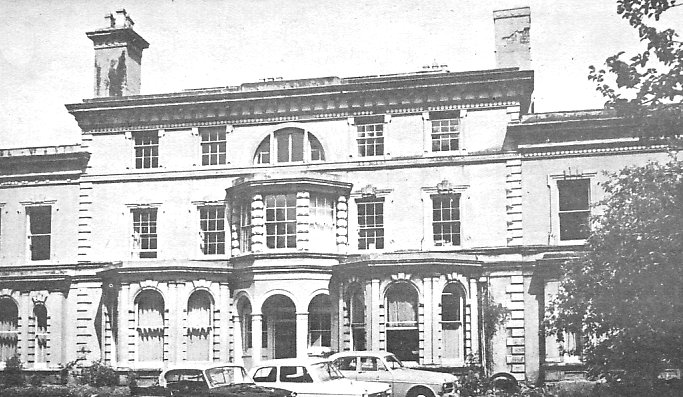
The Thorneycroft family's Wolverhampton home,
Chapel House, on Tettenhall Road.
|
George was a very happy family man, who
once said of Eleanor, his wife “I am indebted to providence
for one of the best women ever made, and blessed with a
family of children who are all I could wish.” They had two
sons and seven daughters, but sadly four of the children
died young. The children were as follows:
| Ann |
|
born in Willenhall in 1816, died 1822 |
| Mary |
|
born in Willenhall in 1818 |
| John
|
|
born in Willenhall in 1820, died young |
| Emma
|
|
born in Willenhall in 1821 |
| Thomas
|
|
born in Willenhall in 1822 |
| Ann
Maria |
|
born in Wolverhampton in 1825, died 1836 |
| Harriet |
|
born in Wolverhampton in 1827 |
| Ellen |
|
born in Wolverhampton in 1830 |
| Hannah
|
|
born in Wolverhampton in 1833, died young |
In Wolverhampton the family lived in
style at Chapel House, on Tettenhall Road. A wing was added
on either side, and it was later divided into two to form
Granville House and Salisbury House. As the children got
older, George built ‘Summerfield’ in the grounds of Chapel
House as a home for Mary. After her marriage, Emma and Ellen
began their married life there. The four girls married men
who became prominent in the town.
Mary married Charles Corser a
Wolverhampton solicitor.
Emma married John Hartley in 1839. He
hailed from Scotland and owned Hartley's Glassworks in
Sunderland. He moved to Wolverhampton, and in 1828 became a
partner in Chance Glass Works, Smethwick, with Robert Lucas
Chance. He was also a partner in G.B. Thorneycroft &
Company, and became a very wealthy man. When George died the
Hartleys inherited his estate in Wheaton Aston. They added
to the estate by buying more and more property, and then
sought a grander residence as befitting their new status as
landed gentry. In 1858 John and Emma leased Tong Castle from
the Earl of Bradford, and until his death in 1884, Hartley
was referred to as the Squire.
Harriet married Charles Perry,
the eldest son of Thomas Perry who founded Thomas Perry &
Son Limited at Highfield Works, Bilston.
Ellen married Henry Hartley
Fowler who trained as a solicitor, and came to Wolverhampton
as a partner to Charles Corser. He was elected to the
Council as member for St. Matthew’s Ward, and became mayor
in 1862/3. He then stood for Parliament and was elected with
a large majority. Because of his support for the
Wolverhampton Corporation Act of 1891 he was made a freeman
of the Borough in 1892. In 1908 he was raised to the peerage
as Viscount Wolverhampton.
Thomas, the most well-known of
the children, married Jane Whitelaw. He became a wealthy
industrialist, a landowner, and a well-known
Conservative. He was known as Colonel Thorneycroft because
he was a Lieutenant Colonel in the Staffordshire Yeomanry.
He is remembered for his wonderful home, Tettenhall Towers,
now part of Tettenhall College, and for his flamboyant
lifestyle, his inventions, and eccentricities.
In 1850 George purchased the old
Molineux estate in Willenhall, and in 1851 gave the land for
Wood Street Cemetery in Willenhall to the Methodist church.
The cemetery soon filled and no further interments were
allowed, except in existing graves. He also acquired a large
estate in Wheaton Aston.
George became an authority on the
manufacture of malleable iron, and on railway wheels and
axles. In 1850 he became an associate member of the
Institute of Civil Engineers, and gave a paper to them
entitled 'On the manufacture of Malleable Iron and the
Strength of Railway Axles'. For this work he was awarded the
Telford Medal.
George Thorneycroft
never recovered from the effects of the boiler explosion in
Willenhall. As time progressed he grew weaker, eventually
becoming bedridden. In the early part of 1851 he
suffered from brain disease, and appeared to improve, but a
relapse took place, and he died on 28th
April, 1851, at the age of 60.
He had a massive
funeral. The streets must have been lined with people, all
the way from the town centre to the church and the cemetery.
Around 20,000 people came to view the proceedings and pay
their last respects. Shops and businesses in Wolverhampton
closed between 11 a.m. and 1 p.m. The corporation was
entertained for lunch by Charles Corser, before they led a
long procession through the town, which included one
thousand of George’s workmen, many of his fellow
ironmasters, and his private carriage, which had the blinds
drawn, and was driven by Thomas Spilsbury, George’s
favourite servant.
The funeral service
took place at St. Mark’s Church, and George was buried in
Merridale Cemetery. After his death around 1,000
Shrubbery workers subscribed to a bronzed cast-iron
monument, erected in the cemetery, to commemorate the life
of a well-respected employer. A colossal marble statue of
George Benjamin Thorneycroft produced by the sculptor,
Thomas Thorneycroft of London, was erected on a plinth next
to the grave. It must have been an impressive sight.
Although the plinth still remains, the cast iron monument
has gone, and the statue was moved to the entrance hall of
the new Town Hall in 1871.
When Eleanor died on 5th January, 1874
she was buried alongside her late husband. One other member
of the family is also in the grave. It is their daughter
Mary Corser who died on 18th December, 1897 at the age of
80.
Shortly after his death
George was honoured at the Great Exhibition of 1851.
G.B. Thorneycroft & Company received a prize medal for their
exhibit of Brigg’s patent compound axle, tyre, and rails. |
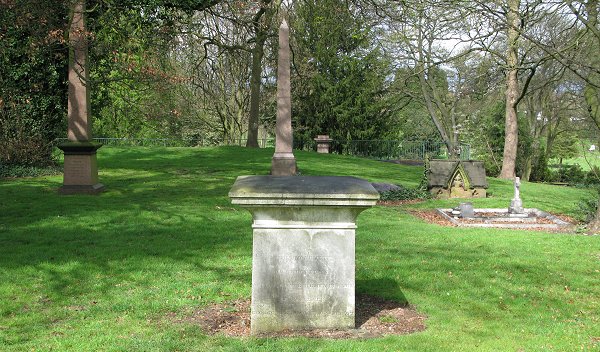
George, Eleanor, and Mary's grave in Merridale
Cemetery.
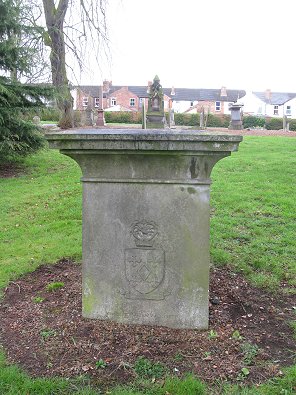 |
|
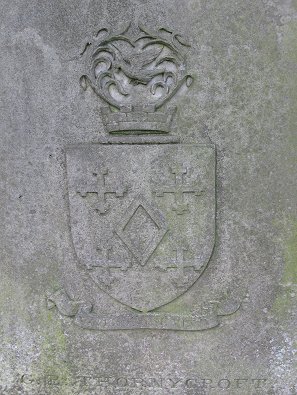 |
|
Two views of
the back of the grave which displays the family
crest, and George's name. |
|
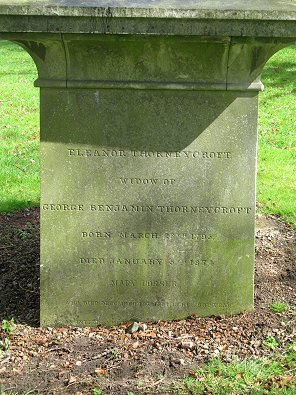 |
|
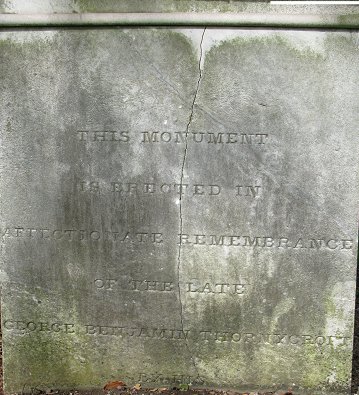 |
|
Another two
views of the grave. |
|
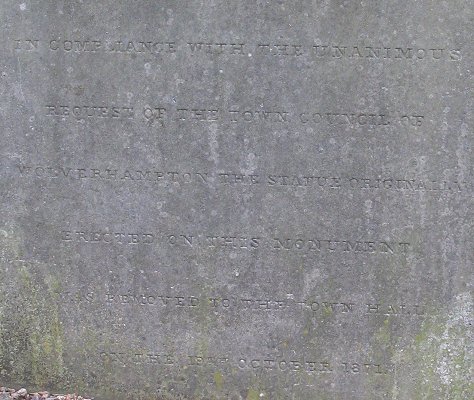 |
On the side of the grave is the
following inscription that was added by Wolverhampton
Council:
In compliance with
the unanimous
request of the
Town Council of
Wolverhampton the
statue originally
erected on this
monument
was removed to the
Town Hall
on the 19th October
1871. |
 |
Return to the
previous page |
|
|